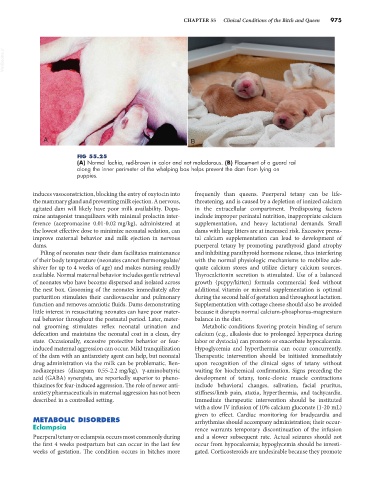Page 1003 - Small Animal Internal Medicine, 6th Edition
P. 1003
CHAPTER 55 Clinical Conditions of the Bitch and Queen 975
VetBooks.ir
A B
FIG 55.25
(A) Normal lochia, red-brown in color and not malodorous. (B) Placement of a guard rail
along the inner perimeter of the whelping box helps prevent the dam from lying on
puppies.
induces vasoconstriction, blocking the entry of oxytocin into frequently than queens. Puerperal tetany can be life-
the mammary gland and preventing milk ejection. A nervous, threatening, and is caused by a depletion of ionized calcium
agitated dam will likely have poor milk availability. Dopa- in the extracellular compartment. Predisposing factors
mine antagonist tranquilizers with minimal prolactin inter- include improper perinatal nutrition, inappropriate calcium
ference (acepromazine 0.01-0.02 mg/kg), administered at supplementation, and heavy lactational demands. Small
the lowest effective dose to minimize neonatal sedation, can dams with large litters are at increased risk. Excessive prena-
improve maternal behavior and milk ejection in nervous tal calcium supplementation can lead to development of
dams. puerperal tetany by promoting parathyroid gland atrophy
Piling of neonates near their dam facilitates maintenance and inhibiting parathyroid hormone release, thus interfering
of their body temperature (neonates cannot thermoregulate/ with the normal physiologic mechanisms to mobilize ade-
shiver for up to 4 weeks of age) and makes nursing readily quate calcium stores and utilize dietary calcium sources.
available. Normal maternal behavior includes gentle retrieval Thyrocalcitonin secretion is stimulated. Use of a balanced
of neonates who have become dispersed and isolated across growth (puppy/kitten) formula commercial feed without
the nest box. Grooming of the neonates immediately after additional vitamin or mineral supplementation is optimal
parturition stimulates their cardiovascular and pulmonary during the second half of gestation and throughout lactation.
function and removes amniotic fluids. Dams demonstrating Supplementation with cottage cheese should also be avoided
little interest in resuscitating neonates can have poor mater- because it disrupts normal calcium-phosphorus-magnesium
nal behavior throughout the postnatal period. Later, mater- balance in the diet.
nal grooming stimulates reflex neonatal urination and Metabolic conditions favoring protein binding of serum
defecation and maintains the neonatal coat in a clean, dry calcium (e.g., alkalosis due to prolonged hyperpnea during
state. Occasionally, excessive protective behavior or fear- labor or dystocia) can promote or exacerbate hypocalcemia.
induced maternal aggression can occur. Mild tranquilization Hypoglycemia and hyperthermia can occur concurrently.
of the dam with an antianxiety agent can help, but neonatal Therapeutic intervention should be initiated immediately
drug administration via the milk can be problematic. Ben- upon recognition of the clinical signs of tetany without
zodiazepines (diazepam 0.55-2.2 mg/kg), γ-aminobutyric waiting for biochemical confirmation. Signs preceding the
acid (GABA) synergists, are reportedly superior to pheno- development of tetany, tonic-clonic muscle contractions
thiazines for fear-induced aggression. The role of newer anti- include behavioral changes, salivation, facial pruritus,
anxiety pharmaceuticals in maternal aggression has not been stiffness/limb pain, ataxia, hyperthermia, and tachycardia.
described in a controlled setting. Immediate therapeutic intervention should be instituted
with a slow IV infusion of 10% calcium gluconate (1-20 mL)
given to effect. Cardiac monitoring for bradycardia and
METABOLIC DISORDERS arrhythmias should accompany administration; their occur-
Eclampsia rence warrants temporary discontinuation of the infusion
Puerperal tetany or eclampsia occurs most commonly during and a slower subsequent rate. Actual seizures should not
the first 4 weeks postpartum but can occur in the last few occur from hypocalcemia; hypoglycemia should be investi-
weeks of gestation. The condition occurs in bitches more gated. Corticosteroids are undesirable because they promote

